Tākaka on:
[Wikipedia]
[Google]
[Amazon]
Tākaka is a small town situated at the southeastern end of
 The area around Tākaka Hill is dominated by its
The area around Tākaka Hill is dominated by its
 There is also a small Fonterra factory located in the township of Tākaka that produces skim milk powder. There are 83 dairy farms supplying the factory, which can process about a day into skim milk powder. Cream is produced as a by-product, and is shipped to the Clandeboye factory for further processing. The $80 million Takaka dairy factory was damaged by a fire in 2005. More than 60 firefighters battled the fire, which was caused by contractors completing welding work. It has subsequently been rebuilt. In 2009, it was reported that it employed nearly 50 staff and contributed $3 million in wages to the local economy.
There is also a small Fonterra factory located in the township of Tākaka that produces skim milk powder. There are 83 dairy farms supplying the factory, which can process about a day into skim milk powder. Cream is produced as a by-product, and is shipped to the Clandeboye factory for further processing. The $80 million Takaka dairy factory was damaged by a fire in 2005. More than 60 firefighters battled the fire, which was caused by contractors completing welding work. It has subsequently been rebuilt. In 2009, it was reported that it employed nearly 50 staff and contributed $3 million in wages to the local economy.
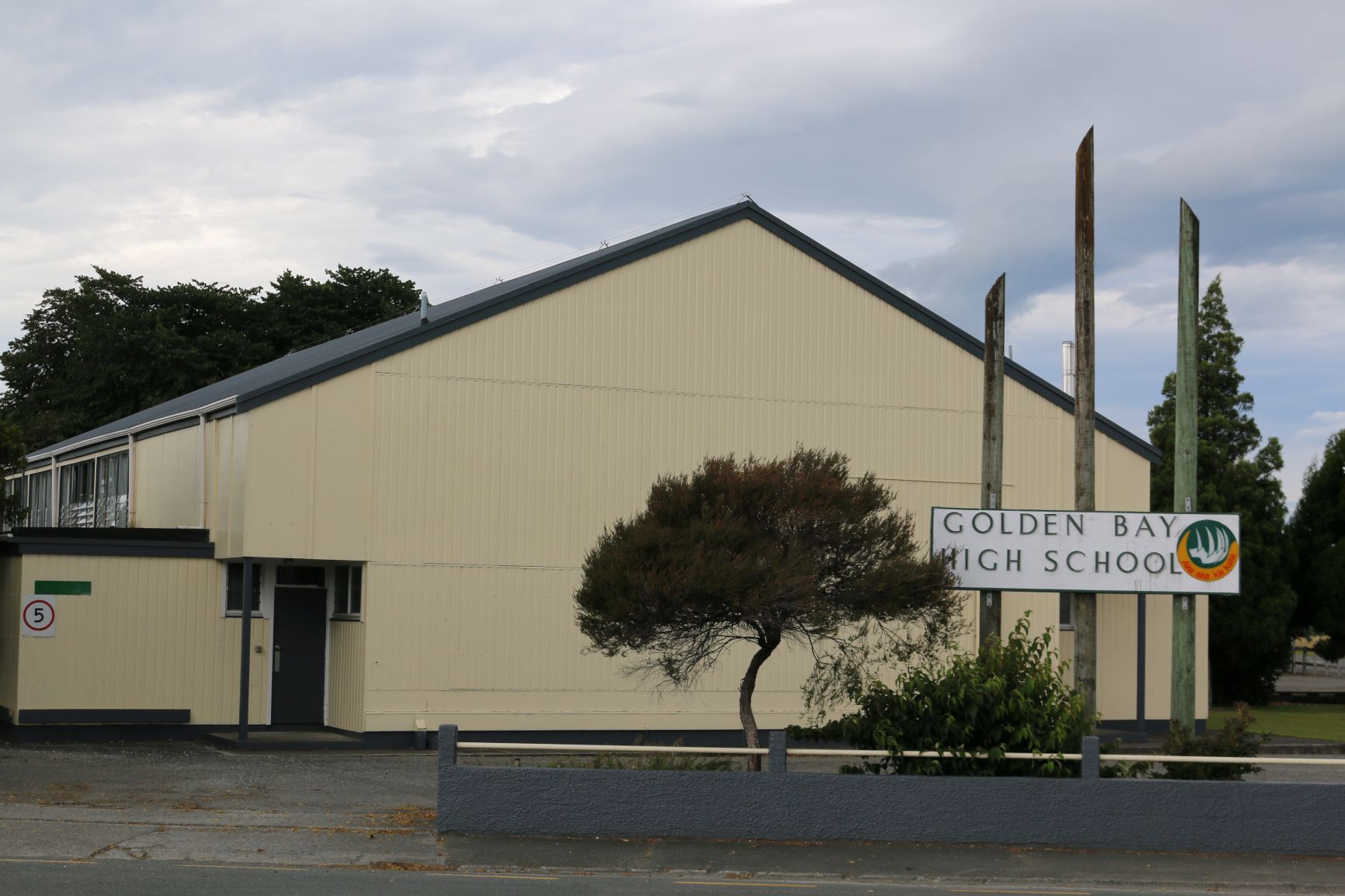
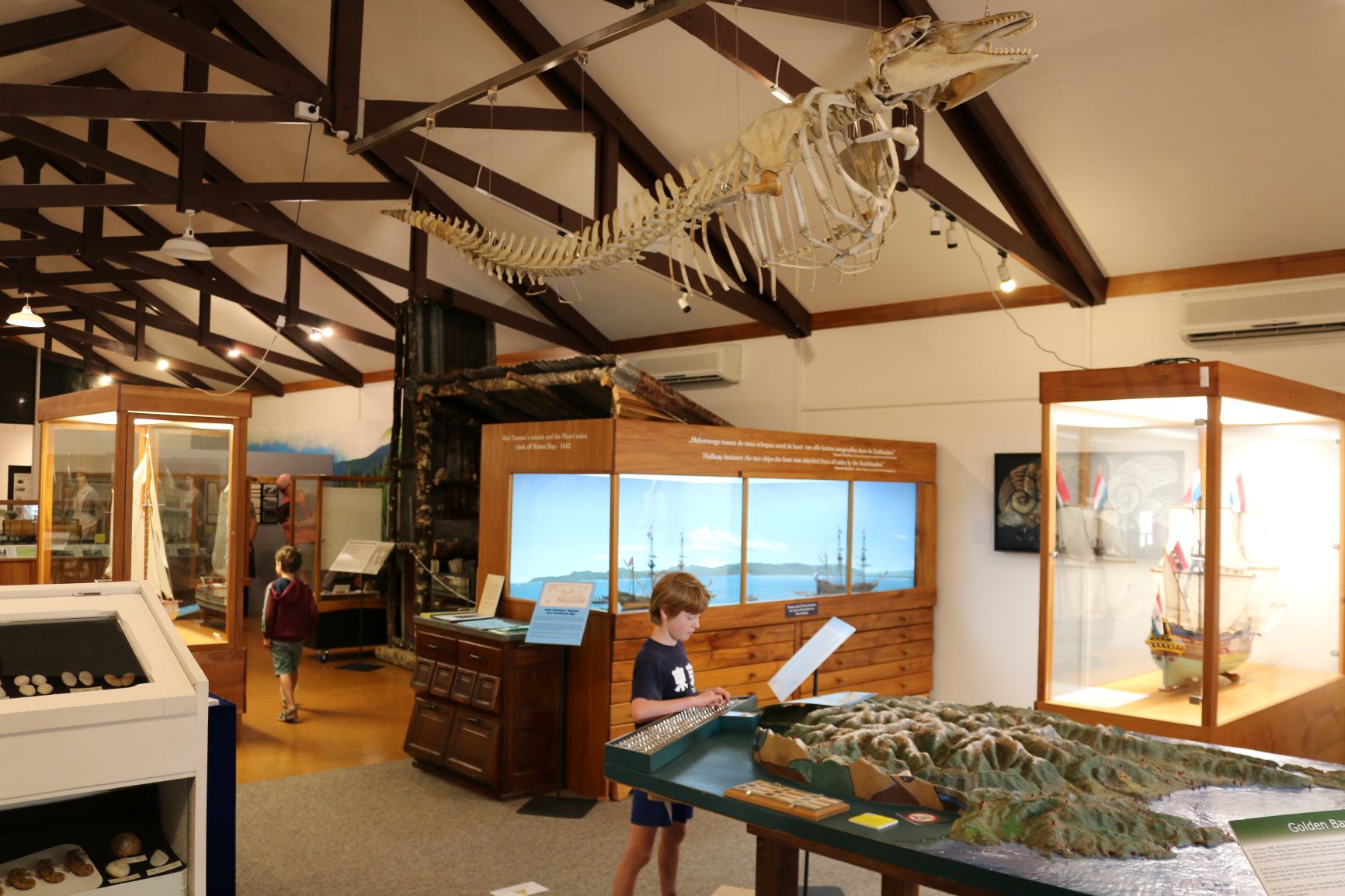 The Golden Bay Museum – Te Waka Huia o Mohua has displays on
The Golden Bay Museum – Te Waka Huia o Mohua has displays on
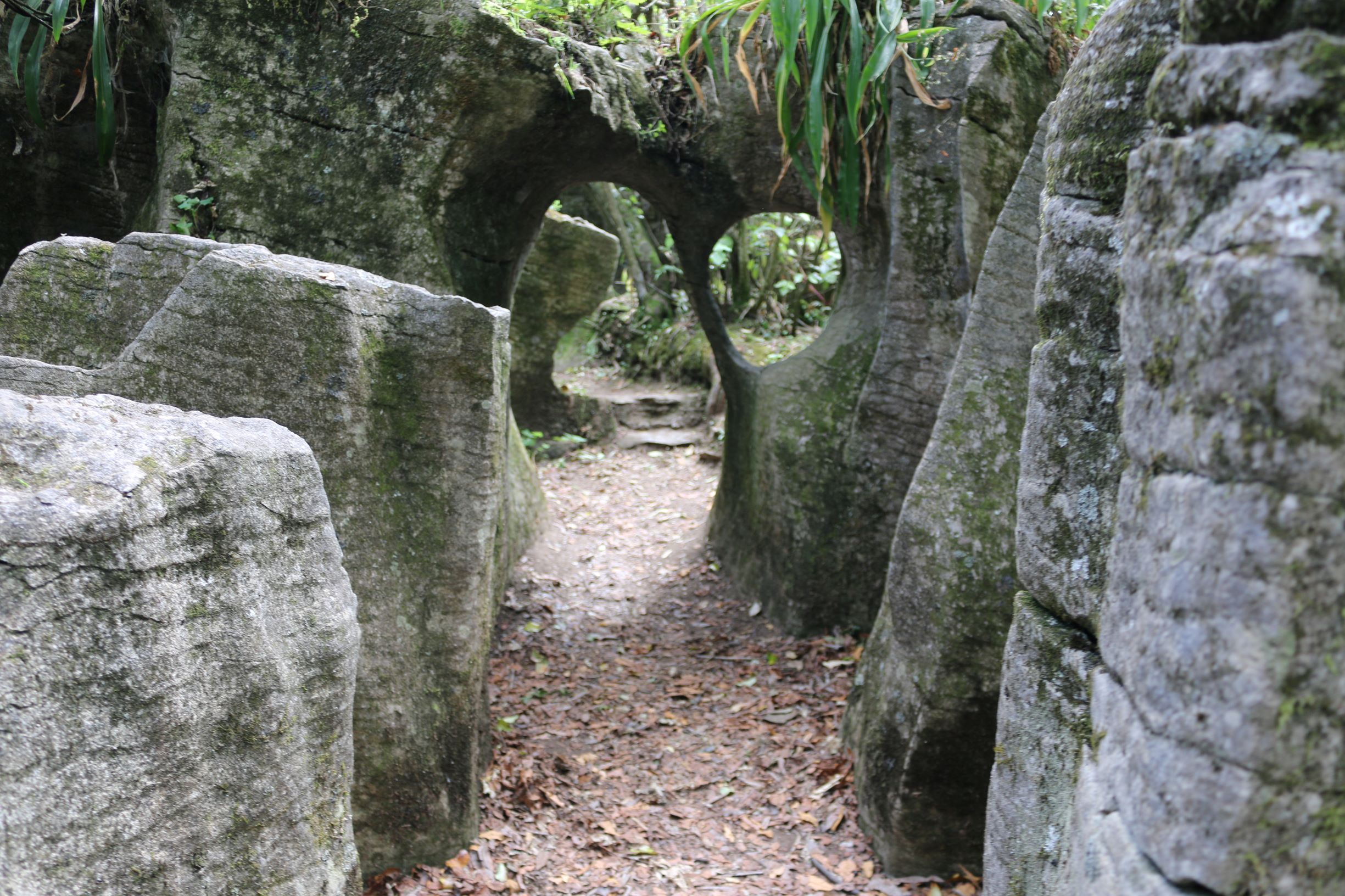 The Labyrinth Rocks Park is located on Scott Road. It is a natural rock maze. Shaped by the chemistry of rainfall and rock, it is a part of the Takaka Hill
The Labyrinth Rocks Park is located on Scott Road. It is a natural rock maze. Shaped by the chemistry of rainfall and rock, it is a part of the Takaka Hill
 Paines Ford (also known as Paynes Ford) is a swimming hole and rock climbing spot on the confluence of the Waingara and Takaka rivers. An easy trail from the carpark follows the route of a tramline, that existed to haul timber out of the surrounding forest in the early 1880s, to a number of swimming holes surrounded by limestone rock formations. The entrance and carpark is located at 1886 Takaka Valley, Highway SH60, which is south of central Takaka. Alternatively, it is about a 20 minutes walk from Tākaka. Paines Ford has over 200 bolted climbs. The most famous climb is ''1080 and the letter G'' because of its unique "no-hands-rest" at the top and its views of Golden Bay.
Paines Ford (also known as Paynes Ford) is a swimming hole and rock climbing spot on the confluence of the Waingara and Takaka rivers. An easy trail from the carpark follows the route of a tramline, that existed to haul timber out of the surrounding forest in the early 1880s, to a number of swimming holes surrounded by limestone rock formations. The entrance and carpark is located at 1886 Takaka Valley, Highway SH60, which is south of central Takaka. Alternatively, it is about a 20 minutes walk from Tākaka. Paines Ford has over 200 bolted climbs. The most famous climb is ''1080 and the letter G'' because of its unique "no-hands-rest" at the top and its views of Golden Bay.
 The Masonic lodge was originally built as a cinema in 1926 outside the town boundary, as for reasons unknown, a cinema was not permitted in the town. It was a popular addition to the town before being sold in 1937 and became the Masonic lodge. The Collingwood Lodge and the Takaka Lodge merged in 1972 became the Golden Bay Lodge No 144.
The Masonic lodge was originally built as a cinema in 1926 outside the town boundary, as for reasons unknown, a cinema was not permitted in the town. It was a popular addition to the town before being sold in 1937 and became the Masonic lodge. The Collingwood Lodge and the Takaka Lodge merged in 1972 became the Golden Bay Lodge No 144.
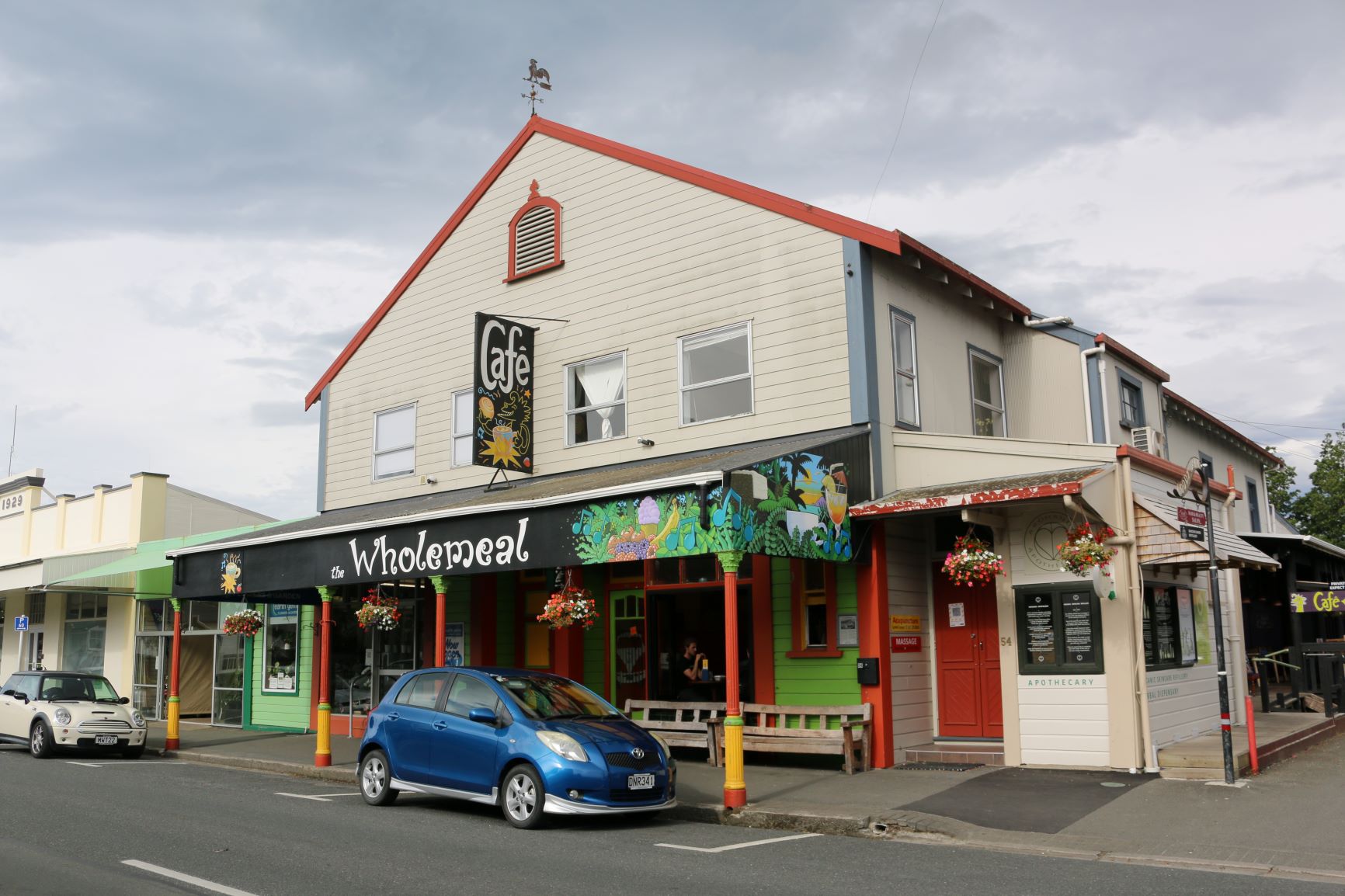
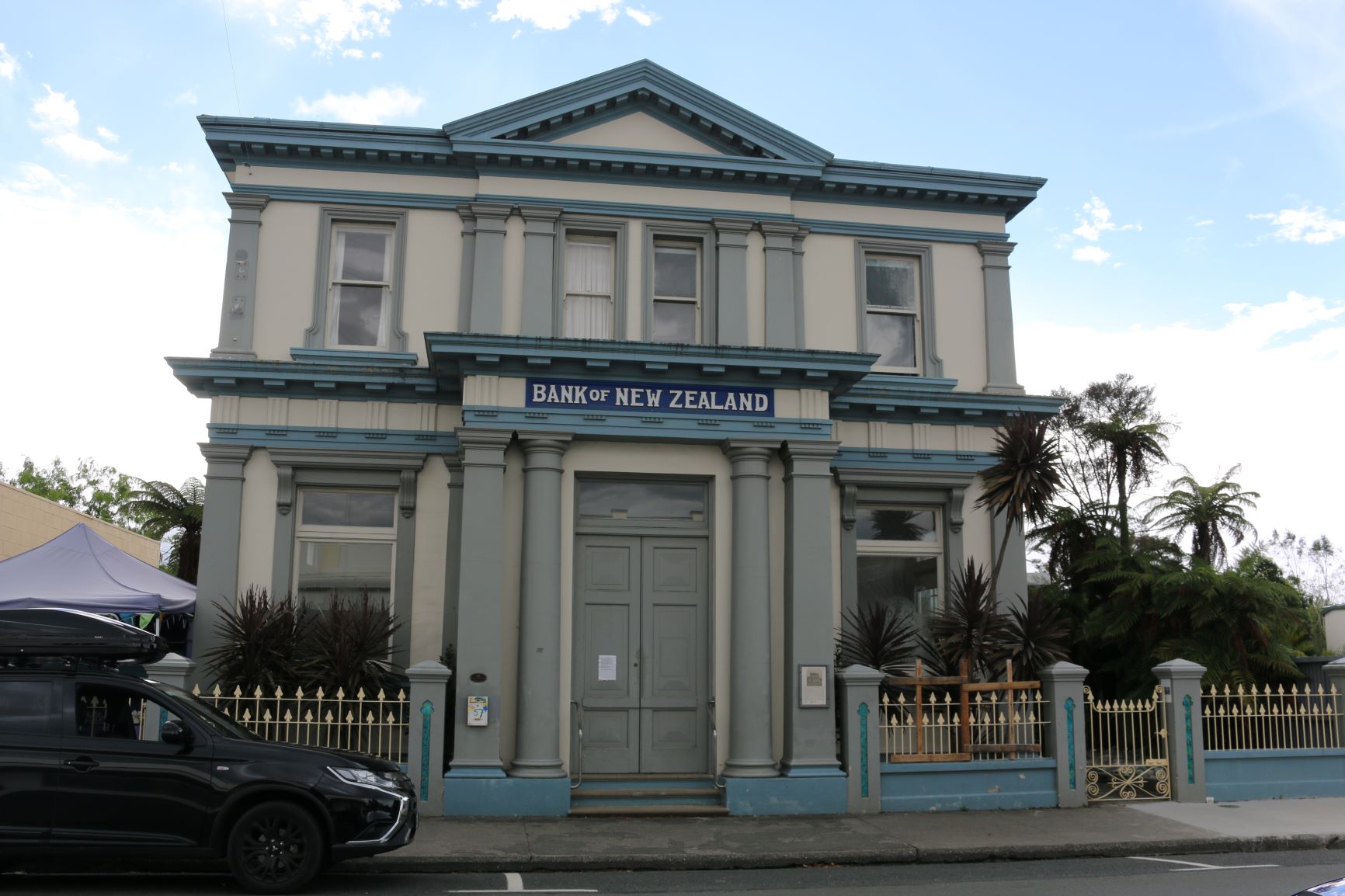 The Bank of New Zealand first engaged in business in Tākaka in 1884 based in a local hotel. The bank moved into the premises pictured in 1915. The building was built out of reinforced concrete supplied by the Golden Bay Cement Company. Gas lighting was initially used and this was replaced with electric lighting in 1930. The bank survived the Murchison earthquake of 1929 without any structural damage. In 1983 floods entered the bank but did little damage. The building is currently used as an art gallery.
The Bank of New Zealand first engaged in business in Tākaka in 1884 based in a local hotel. The bank moved into the premises pictured in 1915. The building was built out of reinforced concrete supplied by the Golden Bay Cement Company. Gas lighting was initially used and this was replaced with electric lighting in 1930. The bank survived the Murchison earthquake of 1929 without any structural damage. In 1983 floods entered the bank but did little damage. The building is currently used as an art gallery.
 On this site in Commercial Street was originally a blacksmith. In 1929, the Golden Bay Electricity Board opened the building and occupied it until 2000. It is now occupied by the Department of Conservation.
On this site in Commercial Street was originally a blacksmith. In 1929, the Golden Bay Electricity Board opened the building and occupied it until 2000. It is now occupied by the Department of Conservation.
 The Telegraph Hotel was built over 100 years ago.
The Telegraph Hotel was built over 100 years ago.
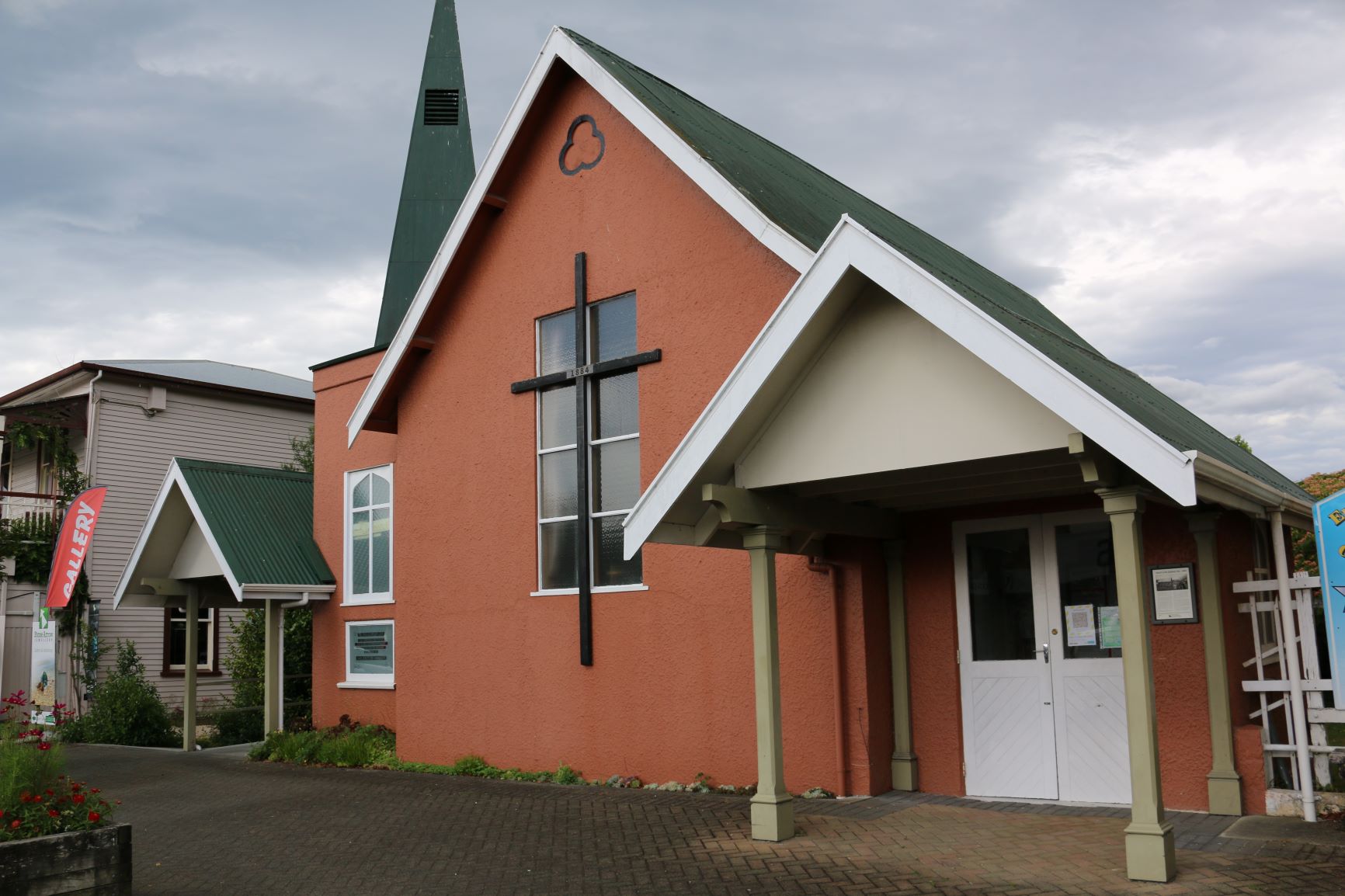 The Anglican church of the Epiphany is situated on Commercial Street. It was consecrated by the Bishop of Nelson in 1884. It was built from locally sawn matai and totara timber. A bell tower was added in 1900 and by 1960 the timber was covered in stucco. The bell tower was replaced in 1966 and the church was extended in 2002.
The Anglican church of the Epiphany is situated on Commercial Street. It was consecrated by the Bishop of Nelson in 1884. It was built from locally sawn matai and totara timber. A bell tower was added in 1900 and by 1960 the timber was covered in stucco. The bell tower was replaced in 1966 and the church was extended in 2002.
 The Church of the Sacred Heart was designed by Nelson architect Arthur Griffin, and built at a cost of £1250 using locally sourced marble. It was formally opened on 15 September 1918. The church requires structural strengthening to bring it up to the building code requirements and has not been used since 2011.
The Church of the Sacred Heart was designed by Nelson architect Arthur Griffin, and built at a cost of £1250 using locally sourced marble. It was formally opened on 15 September 1918. The church requires structural strengthening to bring it up to the building code requirements and has not been used since 2011.
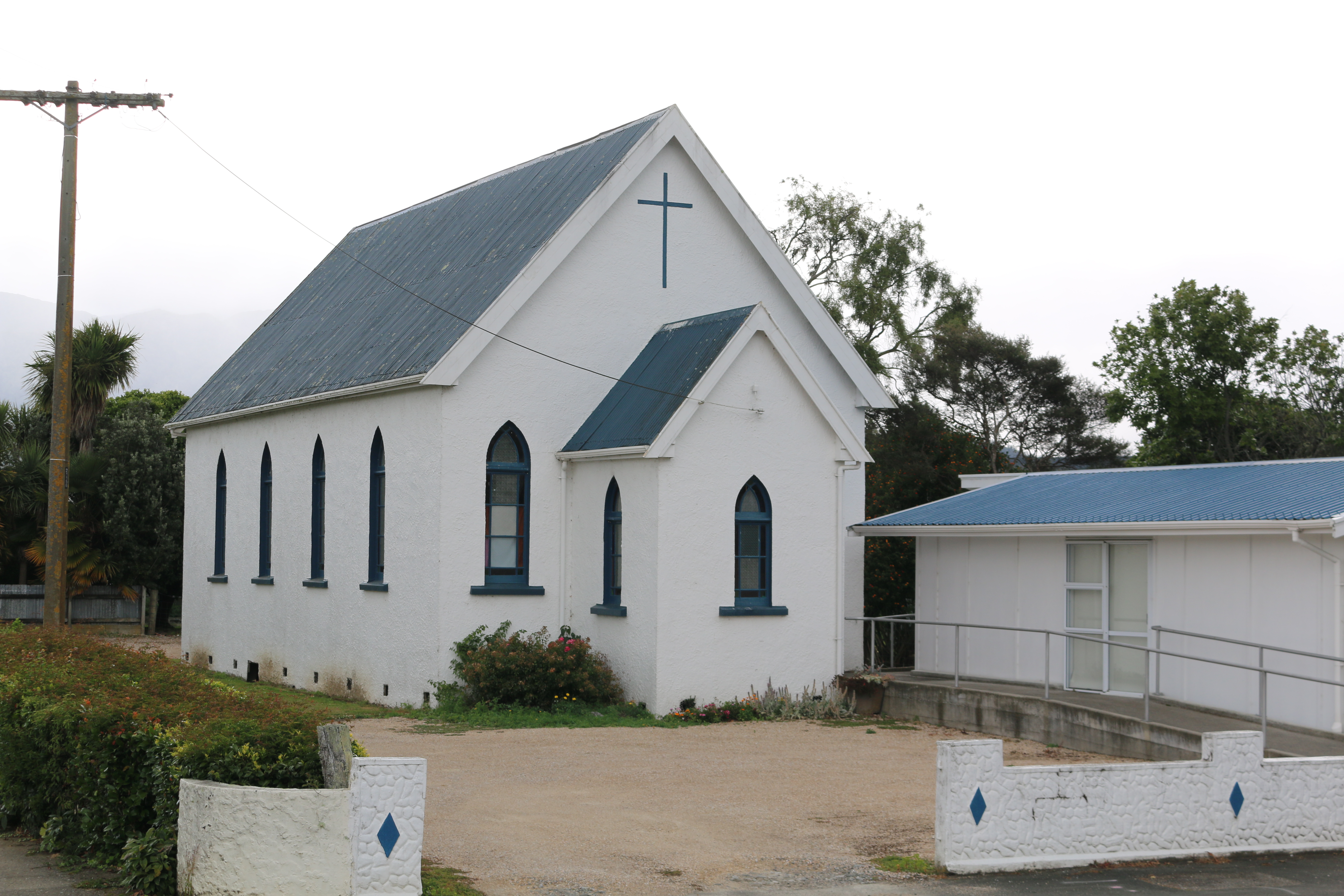 St Andrew's is located on Commercial Street, Tākaka.
St Andrew's is located on Commercial Street, Tākaka.
 The Eureka boarding house was built in 1906. A milk bar was added to the front of the building in the 1950s. It has since been modified further to provide more shop frontage.
The Eureka boarding house was built in 1906. A milk bar was added to the front of the building in the 1950s. It has since been modified further to provide more shop frontage.
Golden Bay Golden Bay may refer to:
* Golden Bay / Mohua
Golden Bay / Mohua is a large shallow bay in New Zealand's Tasman District, near the northern tip of the South Island. An arm of the Tasman Sea, the bay lies northwest of Tasman Bay / Te Tai-o-Aore ...
, at the northern end of New Zealand's South Island
The South Island ( , 'the waters of Pounamu, Greenstone') is the largest of the three major islands of New Zealand by surface area, the others being the smaller but more populous North Island and Stewart Island. It is bordered to the north by ...
, located on the lower reaches of the Tākaka River
The Tākaka River lies in the northwest of New Zealand's South Island. It runs north for 70 kilometres, entering Golden Bay near the town of Tākaka.
Naming
Manawhenua Ki Mohua, an iwi-mandated organisation representing Ngāti Tama, Ngāti R ...
. State Highway 60 runs through Takaka and follows the river valley before climbing over Tākaka Hill
Tākaka Hill, previously also referred to as Marble Mountain, is a range of hills in the northwest of the South Island of New Zealand. Made of marble that has weathered into many strange forms and with numerous sinkholes, it is typical karst cou ...
, to Motueka
Motueka is a town in the South Island of New Zealand, close to the mouth of the Motueka River on the western shore of Tasman Bay. It is the second largest in the Tasman Region, with a population of as of
The surrounding district has a numb ...
(57 km away) linking Golden Bay with the more populated coast of Tasman Bay
Tasman Bay (; officially Tasman Bay / Te Tai-o-Aorere), originally known in English as Blind Bay, is a large V-shaped bay at the north end of New Zealand's South Island. Located in the centre of the island's northern coast, it stretches alon ...
to the southeast. The town is served by Tākaka Aerodrome
The Tākaka Aerodrome serves the town of Tākaka, in the South Island of New Zealand.
Description
Tākaka Aerodrome is northwest of the town. State Highway 60 runs just south of Runway 36. It was established in 1940 and is owned by the Tasman D ...
.
History
The area has long hadMāori
Māori or Maori can refer to:
Relating to the Māori people
* Māori people of New Zealand, or members of that group
* Māori language, the language of the Māori people of New Zealand
* Māori culture
* Cook Islanders, the Māori people of the Co ...
settlement. An early nation is Ngāti Tumatakōkiri, then Ngāti Apa
Ngāti Apa is a Māori iwi (tribe) in Rangitikei District of New Zealand. Its rohe (traditional tribal lands) extend between the Mangawhero, Whangaehu, Turakina and Rangitīkei rivers. This area is bounded by Whanganui River in the north-west ...
and today the iwi are known as Manawhenua ki Mohua Ngāti Tama
Ngāti Tama is a Māori people, Māori iwi, tribe of New Zealand. Their origins, according to oral tradition, date back to Tama Ariki, the chief navigator on the Tokomaru (canoe), Tokomaru waka (canoe), waka. Their historic region is in north Tar ...
, Ngāti Rarua and Te Āti Awa
Te Āti Awa or Te Ātiawa is a Māori iwi with traditional bases in the Taranaki and Wellington regions of New Zealand. Approximately 17,000 people registered their affiliation to Te Āti Awa in 2001, with about 10,000 in Taranaki, 2,000 in We ...
, these nations (iwi) migrating from the North Island in the 1820s.
The name of the town may derive from Taha'a island in the Society Islands
The Society Islands ( , officially ; ) are an archipelago in the South Pacific Ocean that includes the major islands of Tahiti, Mo'orea, Moorea, Raiatea, Bora Bora and Huahine. Politically, they are part of French Polynesia, an overseas country ...
in French Polynesia
French Polynesia ( ; ; ) is an overseas collectivity of France and its sole #Governance, overseas country. It comprises 121 geographically dispersed islands and atolls stretching over more than in the Pacific Ocean, South Pacific Ocean. The t ...
. A local myth about a taniwha in the nearby Parapara River
The Parapara River is a river of the Tasman Region of New Zealand's South Island. It flows generally north from its watershed in the Kahurangi National Park, reaching Golden Bay at the small settlement of Parapara, 5 kilometres south of Colli ...
is similar to one told about the Parapara strait, which separates Taha'a from Motue'a island.
From 1853 to 1876, Tākaka was administered as part of the Nelson Province
Nelson Province was constituted in 1853 under the New Zealand Constitution Act 1852, and originally covered the entire upper South Island, including all of present-day Buller District, Buller, Kaikoura District, Kaikoura, Marlborough District, ...
. Sawmilling was an important business for Tākaka in the 1870s. The Takaka tramway
The Takaka Tramway was a narrow gauge light railway that operated in the Tākaka Valley, Golden Bay / Mohua, Golden Bay, New Zealand, from 1882 to 1905, linking farms and sawmills of the Takaka Valley with the tidal port of Waitapu at the mouth ...
was built in 1880. Prior to that time timber was transported to the port by teams of bullocks which would often leave the main street of Tākaka looking like a rutted bog. After flooding in 1904 did significant damage to the tramway, it was sold in 1905 and the locomotive, rolling stock and rails were shipped to Onehunga
Onehunga is a suburb of Auckland in New Zealand and the location of the Port of Onehunga, the city's small port on the Manukau Harbour. It is south of the city centre, close to the volcanic cone of Maungakiekie / One Tree Hill.
Onehunga is ...
by sea.
Tākaka contributed soldiers to the Boer War
The Second Boer War (, , 11 October 189931 May 1902), also known as the Boer War, Transvaal War, Anglo–Boer War, or South African War, was a conflict fought between the British Empire and the two Boer republics (the South African Republic an ...
, the First World War and the Second World War with 1, 44 and 25 respectively dying in each conflict.
Onetahua Kokiri Marae (Manawhenua ki Mohua) in Pohara Valley was established in 1986, used a re-purposed school in 1992 and in 2001 a meeting house named ''Te Ao Marama'' was opened. The name comes from the name for Farewell Spit
Farewell Spit () is a narrow sand spit at the northern end of the Golden Bay, in the South Island of New Zealand. The spit includes around of stable land and another of mobile sand spit running eastwards from Cape Farewell, the northern-mos ...
. Te Ātiawa te Waka a Māui state that "Onetahua connects ancestrally to the waka Tokomaru, the maunga Parapara and the awa Waikoropupu".
In June 2005, much of the town was temporarily evacuated after fire swept through Tākaka's biggest industrial complex, a dairy factory. There were fears that volatile chemicals stored at the plant might explode, leading to the release of poisonous gases, which later proved to be unfounded.
In July 2020, the name of the town was officially gazetted as Tākaka by the New Zealand Geographic Board
The New Zealand Geographic Board Ngā Pou Taunaha o Aotearoa (NZGB) is the authority over geographical and hydrographic names within New Zealand and its territorial waters. This includes the naming of small urban settlements, localities, mounta ...
.
Geography
 The area around Tākaka Hill is dominated by its
The area around Tākaka Hill is dominated by its karst
Karst () is a topography formed from the dissolution of soluble carbonate rocks such as limestone and Dolomite (rock), dolomite. It is characterized by features like poljes above and drainage systems with sinkholes and caves underground. Ther ...
geology. This creates sinkholes and cave systems, including New Zealand's deepest vertical shaft, Harwoods Hole
Harwoods Hole is a cave system located in the northwest of the South Island of New Zealand, in the Abel Tasman National Park. At , it is New Zealand's deepest vertical shaft. It was first explored in 1958, long after it was discovered.
Formati ...
. Lake Killarney in Tākaka is a sinkhole filled with groundwater.
Tākaka and Golden Bay are known for rock climbing
Rock climbing is a climbing sports discipline that involves ascending climbing routes, routes consisting of natural rock in an outdoor environment, or on artificial resin climbing walls in a mostly indoor environment. Routes are documented in c ...
, particularly around the area of Paines Ford.
The town is also known for Te Waikoropupū Springs
Te Waikoropupū Springs, also known as Pupu Springs and Waikaremumu Springs, are located near Tākaka in Golden Bay, in the Tasman District of the South Island of New Zealand. The springs are known for the exceptional clarity of the water, and ...
(colloquially known as Pupu Springs).
The antipode of Tākaka is the town of Coriscada, Portugal.
Climate
Tākaka is one of the warmest locations in the South Island, due to its northerly position and maritime influences from the Golden Bay. Because of the hills in the Kahurangi National Park to the south-west of Tākaka, the town receives substantially less rainfall than the West Coast. Tākaka's location on the leeward side of these hills allow the wind to become warmer and drier as it flows down towards the town, allowing an average of 22 days a year to exceed 26.7 °C (80 °F). On the contrary, being a few kilometres inland, cold air can settle over Tākaka on winter mornings, resulting in an average of 17.2 frosty days per year.Economy
Farming, sawmilling,limestone
Limestone is a type of carbonate rock, carbonate sedimentary rock which is the main source of the material Lime (material), lime. It is composed mostly of the minerals calcite and aragonite, which are different Polymorphism (materials science) ...
quarrying and tourism are major local industries. The area around Tākaka is mineral-rich, with gold
Gold is a chemical element; it has chemical symbol Au (from Latin ) and atomic number 79. In its pure form, it is a brightness, bright, slightly orange-yellow, dense, soft, malleable, and ductile metal. Chemically, gold is a transition metal ...
, iron ore
Iron ores are rocks and minerals from which metallic iron can be economically extracted. The ores are usually rich in iron oxides and vary in color from dark grey, bright yellow, or deep purple to rusty red. The iron is usually found in the f ...
, copper
Copper is a chemical element; it has symbol Cu (from Latin ) and atomic number 29. It is a soft, malleable, and ductile metal with very high thermal and electrical conductivity. A freshly exposed surface of pure copper has a pinkish-orang ...
, silver
Silver is a chemical element; it has Symbol (chemistry), symbol Ag () and atomic number 47. A soft, whitish-gray, lustrous transition metal, it exhibits the highest electrical conductivity, thermal conductivity, and reflectivity of any metal. ...
and asbestos
Asbestos ( ) is a group of naturally occurring, Toxicity, toxic, carcinogenic and fibrous silicate minerals. There are six types, all of which are composed of long and thin fibrous Crystal habit, crystals, each fibre (particulate with length su ...
all found locally, although not all in commercially viable amounts.
Dairy factory
 There is also a small Fonterra factory located in the township of Tākaka that produces skim milk powder. There are 83 dairy farms supplying the factory, which can process about a day into skim milk powder. Cream is produced as a by-product, and is shipped to the Clandeboye factory for further processing. The $80 million Takaka dairy factory was damaged by a fire in 2005. More than 60 firefighters battled the fire, which was caused by contractors completing welding work. It has subsequently been rebuilt. In 2009, it was reported that it employed nearly 50 staff and contributed $3 million in wages to the local economy.
There is also a small Fonterra factory located in the township of Tākaka that produces skim milk powder. There are 83 dairy farms supplying the factory, which can process about a day into skim milk powder. Cream is produced as a by-product, and is shipped to the Clandeboye factory for further processing. The $80 million Takaka dairy factory was damaged by a fire in 2005. More than 60 firefighters battled the fire, which was caused by contractors completing welding work. It has subsequently been rebuilt. In 2009, it was reported that it employed nearly 50 staff and contributed $3 million in wages to the local economy.
Demographics
Tākaka covers and had an estimated population of as of with a population density of people per km2. Tākaka had a population of 1,335 at the2018 New Zealand census
The 2018 New Zealand census, which took place on Tuesday 6 March 2018, was the thirty-fourth national census in New Zealand. The population of New Zealand was counted as 4,699,755 – an increase of 457,707 (10.79%) over the 2013 census.
Resu ...
, an increase of 99 people (8.0%) since the 2013 census, and an increase of 183 people (15.9%) since the 2006 census. There were 552 households, comprising 657 males and 678 females, giving a sex ratio of 0.97 males per female. The median age was 47.0 years (compared with 37.4 years nationally), with 222 people (16.6%) aged under 15 years, 189 (14.2%) aged 15 to 29, 621 (46.5%) aged 30 to 64, and 306 (22.9%) aged 65 or older.
Ethnicities were 94.8% European/Pākehā
''Pākehā'' (or ''Pakeha''; ; ) is a Māori language, Māori-language word used in English, particularly in New Zealand. It generally means a non-Polynesians, Polynesian New Zealanders, New Zealander or more specifically a European New Zeala ...
, 10.8% Māori
Māori or Maori can refer to:
Relating to the Māori people
* Māori people of New Zealand, or members of that group
* Māori language, the language of the Māori people of New Zealand
* Māori culture
* Cook Islanders, the Māori people of the Co ...
, 1.1% Pasifika, 2.0% Asian, and 2.5% other ethnicities. People may identify with more than one ethnicity.
The percentage of people born overseas was 18.4, compared with 27.1% nationally.
Although some people chose not to answer the census's question about religious affiliation, 64.5% had no religion, 24.9% were Christian
A Christian () is a person who follows or adheres to Christianity, a Monotheism, monotheistic Abrahamic religion based on the life and teachings of Jesus in Christianity, Jesus Christ. Christians form the largest religious community in the wo ...
, 0.2% were Hindu
Hindus (; ; also known as Sanātanīs) are people who religiously adhere to Hinduism, also known by its endonym Sanātana Dharma. Jeffery D. Long (2007), A Vision for Hinduism, IB Tauris, , pp. 35–37 Historically, the term has also be ...
, 1.1% were Buddhist
Buddhism, also known as Buddhadharma and Dharmavinaya, is an Indian religion and List of philosophies, philosophical tradition based on Pre-sectarian Buddhism, teachings attributed to the Buddha, a wandering teacher who lived in the 6th or ...
and 1.8% had other religions.
Of those at least 15 years old, 177 (15.9%) people had a bachelor's or higher degree, and 243 (21.8%) people had no formal qualifications. The median income was $24,800, compared with $31,800 nationally. 90 people (8.1%) earned over $70,000 compared to 17.2% nationally. The employment status of those at least 15 was that 483 (43.4%) people were employed full-time, 219 (19.7%) were part-time, and 27 (2.4%) were unemployed.
Water supply and fire fighting
there is no reticulated drinking water supply to the town. The properties in the town rely on private domestic bores that are typically between deep and draw water from the Tākaka Unconfined Gravel Aquifer using surface pumps. Early in 2011, the Tasman District Council consulted with the local community about a proposal to construct a reticulated water supply for the town. The water for the proposed system would be drawn from a deep bore into the aquifer, and given ultraviolet treatment. The indicative cost to the community for the reticulated water supply was stated as $525 per annum for each rateable residential property, over a period of 20 years. This proposal followed earlier similar proposals that were not supported by the community, and it did not proceed. However, this left unresolved an existing problem with inadequate water supplies for fire-fighting in the town. Water for fire fighting had previously been drawn from numerous wells around the town but many problems had been experienced including inoperability, inadequate flow, damage to bores from vandalism, and the risks to fire appliances from gravel entrained in some of the wells. A new fire fighting water supply was built and commissioned in July 2011. The scheme includes a new diameter bore to supplement the existing diameter bore at the Tākaka Fire Station, along with a new bore as a monitoring well. The new 300mm diameter bore was designed to be suitable for supply of potable water as a future-proofing measure. This required that the screen for the bore was below depth, to meet requirements for classification as a "secure" supply for drinking water. A long fire main was installed through the centre of Tākaka, supplying 16 fire hydrants. In January 2024, testing of water samples from three bores in the town indicated contamination that was believed to be linked to run–off from fire fighting at a building supplies store that was destroyed by fire earlier in the month.Education

Golden Bay High School
Golden Bay High School is a secondary school in Tākaka, New Zealand. It is one of two secondary schools in Golden Bay / Mohua; the other one is the Collingwood Area School in Collingwood.
Enrolment
As of , Golden Bay High School has roll o ...
is a co-educational state intermediate and high school for Year 7 to 13 students, with a roll of as of .
There are two primary schools for Year 1 to 6 students: Tākaka Primary School, with a roll of , and Central Takaka School with a roll of .
There is also a primary school in nearby Motupipi.
Features
Golden Bay Museum – Te Waka Huia o Mohua
 The Golden Bay Museum – Te Waka Huia o Mohua has displays on
The Golden Bay Museum – Te Waka Huia o Mohua has displays on Abel Tasman
Abel Janszoon Tasman (; 160310 October 1659) was a Dutch sea explorer, seafarer and exploration, explorer, best known for his voyages of 1642 and 1644 in the service of the Dutch East India Company (VOC). He was the first European to reach New ...
's 1642 encounter with Ngāti Tūmatakōkiri
Ngāti Tūmatakōkiri is a Māori iwi (tribe) of New Zealand, who arrived on the '' Kurahaupō'' waka. In the 1600s the iwi settled northwestern South Island, becoming a major power in the region until the 1800s. In 1642, members of Ngāti T� ...
(the local Māori
Māori or Maori can refer to:
Relating to the Māori people
* Māori people of New Zealand, or members of that group
* Māori language, the language of the Māori people of New Zealand
* Māori culture
* Cook Islanders, the Māori people of the Co ...
tribe), Golden Bay's industrial past, and a pilot whale
Pilot whales are cetaceans belonging to the genus ''Globicephala''. The two Extant taxon, extant species are the long-finned pilot whale (''G. melas'') and the short-finned pilot whale (''G. macrorhynchus''). The two are not readily distinguish ...
skeleton. It opened in 1990 after a fundraising effort by the community purchased the collections of the privately owned Takaka Museum. The current museum is owned and funded by Tasman District Council
Tasman District Council () is the unitary authority#New Zealand, unitary local authority for the Tasman District of New Zealand. The council is led by the mayor of Tasman, who is currently .
History
Tasman District Council was formed on 1 Novem ...
and operated by the Golden Bay Museum Society Inc.
Labyrinth Rocks Park
 The Labyrinth Rocks Park is located on Scott Road. It is a natural rock maze. Shaped by the chemistry of rainfall and rock, it is a part of the Takaka Hill
The Labyrinth Rocks Park is located on Scott Road. It is a natural rock maze. Shaped by the chemistry of rainfall and rock, it is a part of the Takaka Hill karst
Karst () is a topography formed from the dissolution of soluble carbonate rocks such as limestone and Dolomite (rock), dolomite. It is characterized by features like poljes above and drainage systems with sinkholes and caves underground. Ther ...
landscape of sculptured rocks, corrugated walls and vertical clefts. Narrow passages lead to small groves of native bush or to another passage or to a dead end, but the maze is too small to get lost in. Doll figurines and toy dinosaurs poked into crevices add to the labyrinth's fairytale Jurassic Park
''Jurassic Park'', later referred to as ''Jurassic World'', is an American science fiction media franchise created by Michael Crichton, centered on a disastrous attempt to create a theme park of De-extinction#Cloning, cloned dinosaurs. It bega ...
experience. Founded by an English geologist, Dave Whittaker, it is now a public reserve. Entrance is free.
Paines Ford swimming hole and rock climbing
 Paines Ford (also known as Paynes Ford) is a swimming hole and rock climbing spot on the confluence of the Waingara and Takaka rivers. An easy trail from the carpark follows the route of a tramline, that existed to haul timber out of the surrounding forest in the early 1880s, to a number of swimming holes surrounded by limestone rock formations. The entrance and carpark is located at 1886 Takaka Valley, Highway SH60, which is south of central Takaka. Alternatively, it is about a 20 minutes walk from Tākaka. Paines Ford has over 200 bolted climbs. The most famous climb is ''1080 and the letter G'' because of its unique "no-hands-rest" at the top and its views of Golden Bay.
Paines Ford (also known as Paynes Ford) is a swimming hole and rock climbing spot on the confluence of the Waingara and Takaka rivers. An easy trail from the carpark follows the route of a tramline, that existed to haul timber out of the surrounding forest in the early 1880s, to a number of swimming holes surrounded by limestone rock formations. The entrance and carpark is located at 1886 Takaka Valley, Highway SH60, which is south of central Takaka. Alternatively, it is about a 20 minutes walk from Tākaka. Paines Ford has over 200 bolted climbs. The most famous climb is ''1080 and the letter G'' because of its unique "no-hands-rest" at the top and its views of Golden Bay.
Notable buildings
Masonic lodge
 The Masonic lodge was originally built as a cinema in 1926 outside the town boundary, as for reasons unknown, a cinema was not permitted in the town. It was a popular addition to the town before being sold in 1937 and became the Masonic lodge. The Collingwood Lodge and the Takaka Lodge merged in 1972 became the Golden Bay Lodge No 144.
The Masonic lodge was originally built as a cinema in 1926 outside the town boundary, as for reasons unknown, a cinema was not permitted in the town. It was a popular addition to the town before being sold in 1937 and became the Masonic lodge. The Collingwood Lodge and the Takaka Lodge merged in 1972 became the Golden Bay Lodge No 144.
Golden Bay theatre
The Golden Bay theatre was opened in May 1927. Electricity became available in 1929 with a petrol engine used prior to this to provide power. When television arrived, theatre numbers declined and it was used for other public functions. In 1978 it was converted into a cafe and art gallery.
Bank of New Zealand
 The Bank of New Zealand first engaged in business in Tākaka in 1884 based in a local hotel. The bank moved into the premises pictured in 1915. The building was built out of reinforced concrete supplied by the Golden Bay Cement Company. Gas lighting was initially used and this was replaced with electric lighting in 1930. The bank survived the Murchison earthquake of 1929 without any structural damage. In 1983 floods entered the bank but did little damage. The building is currently used as an art gallery.
The Bank of New Zealand first engaged in business in Tākaka in 1884 based in a local hotel. The bank moved into the premises pictured in 1915. The building was built out of reinforced concrete supplied by the Golden Bay Cement Company. Gas lighting was initially used and this was replaced with electric lighting in 1930. The bank survived the Murchison earthquake of 1929 without any structural damage. In 1983 floods entered the bank but did little damage. The building is currently used as an art gallery.
Golden Bay Electricity Board building
 On this site in Commercial Street was originally a blacksmith. In 1929, the Golden Bay Electricity Board opened the building and occupied it until 2000. It is now occupied by the Department of Conservation.
On this site in Commercial Street was originally a blacksmith. In 1929, the Golden Bay Electricity Board opened the building and occupied it until 2000. It is now occupied by the Department of Conservation.
Telegraph Hotel
 The Telegraph Hotel was built over 100 years ago.
The Telegraph Hotel was built over 100 years ago.
Church of the Epiphany
 The Anglican church of the Epiphany is situated on Commercial Street. It was consecrated by the Bishop of Nelson in 1884. It was built from locally sawn matai and totara timber. A bell tower was added in 1900 and by 1960 the timber was covered in stucco. The bell tower was replaced in 1966 and the church was extended in 2002.
The Anglican church of the Epiphany is situated on Commercial Street. It was consecrated by the Bishop of Nelson in 1884. It was built from locally sawn matai and totara timber. A bell tower was added in 1900 and by 1960 the timber was covered in stucco. The bell tower was replaced in 1966 and the church was extended in 2002.
Sacred Heart Catholic Church
 The Church of the Sacred Heart was designed by Nelson architect Arthur Griffin, and built at a cost of £1250 using locally sourced marble. It was formally opened on 15 September 1918. The church requires structural strengthening to bring it up to the building code requirements and has not been used since 2011.
The Church of the Sacred Heart was designed by Nelson architect Arthur Griffin, and built at a cost of £1250 using locally sourced marble. It was formally opened on 15 September 1918. The church requires structural strengthening to bring it up to the building code requirements and has not been used since 2011.
St Andrew's Presbyterian Church
 St Andrew's is located on Commercial Street, Tākaka.
St Andrew's is located on Commercial Street, Tākaka.
Eureka boarding house
 The Eureka boarding house was built in 1906. A milk bar was added to the front of the building in the 1950s. It has since been modified further to provide more shop frontage.
The Eureka boarding house was built in 1906. A milk bar was added to the front of the building in the 1950s. It has since been modified further to provide more shop frontage.
Golf course
The Takaka Golf Club had a number of homes on local farms before shifting to Crown land at Clifton that was able to be rented for a token amount in perpetuity in 1959.References
{{DEFAULTSORT:Takaka Populated places in the Tasman District * Populated places around Golden Bay / Mohua